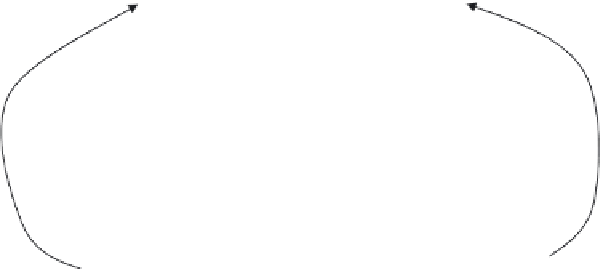Biology Reference
In-Depth Information
Wild-type per mRNA and protein oscillated with a near 24-hour rhythm,
whereas per
L
and per
S
mRNAs and proteins oscillated with long
(29-hour) and short (19-hour) periods, respectively. The per
0
gene
exhibited arrhythmic per mRNA and protein expression. These results
provided the first demonstration of genetic expression patterning
matching a behavioral expression of a whole-organism phenotype (see
Panda et al. [2002].)
Anatomical studies have identified a set of neurons in the adult fly brain
that is the activity-controlling site for behavioral circadian rhythms.
This area of the fly brain seems to be analogous to the mammalian SCN.
Additional studies of a variety of insect species have found similar
molecular mechanisms, including proteins homologous to PER (the
protein product of the period gene), involved in circadian regulation (see
Panda et al. [2002]).
Continued research into the molecular mechanisms responsible for
circadian rhythms revealed that per was not the only gene involved.
Another circadian gene discovered in Drosophila is called timeless (tim).
The timeless protein TIM forms a complex with the period protein PER
that ultimately inhibits its own transcription (see following text and
Figure 11-6). Additional genes have since been identified, and our
understanding of the molecular mechanism for circadian control has
Nucleus
TIM
PER
dCLK
CYC
+
+
tim
cyc
per
dClk
dbt
TIM
CYC
PER
dCLK
DBT
dCLK
CYC
TIM
PER
DBT
PER
Cytoplasm
FIGURE 11-6.
Simplified schematic diagram of the Drosophila circadian clock mechanism. Abbreviations are as
follows: tim and TIM are the timeless gene and protein, respectively; per and PER stand for period
gene and protein, respectively; dbt and DBT for double time; dClk and dCLK for clock; cyc and CYC
for cycle. The doubletime protein DBT phosphorylates free PER protein (i.e., any PER not bound to
TIM) and facilitates its degradation. The dashed arrows represent transcription followed by
translation. In the nucleus, the arrows indicated by a
indicate the elevation of transcription, and
the arrows with the round heads indicate blocking of this activity.
þ

































































